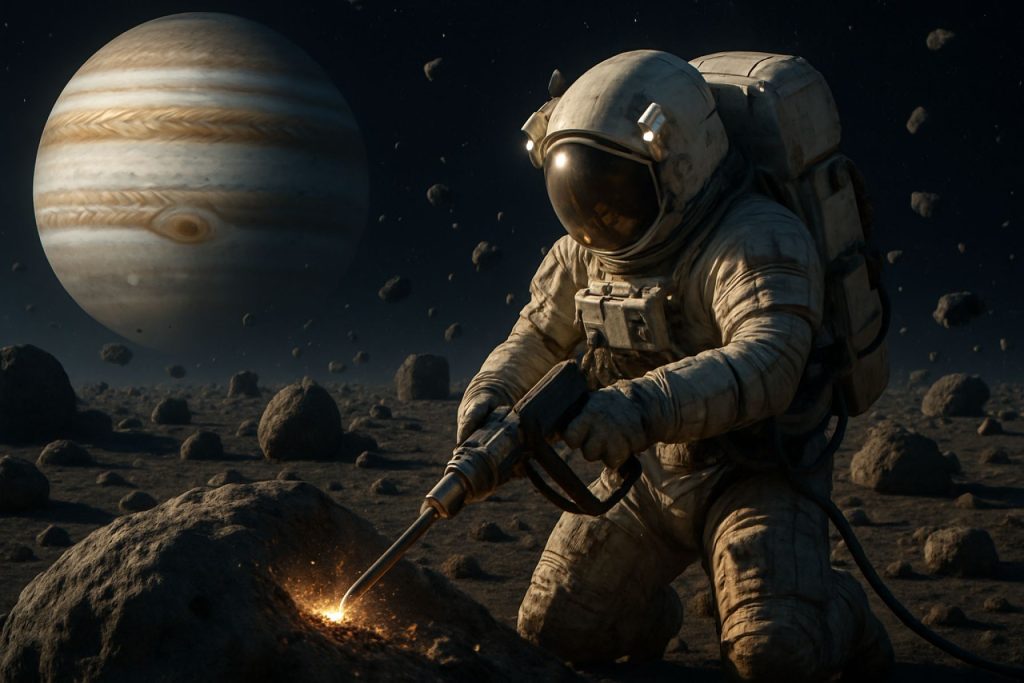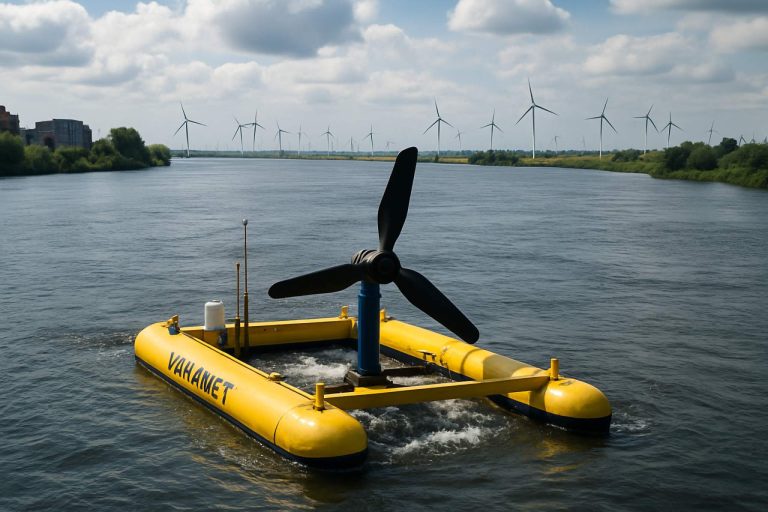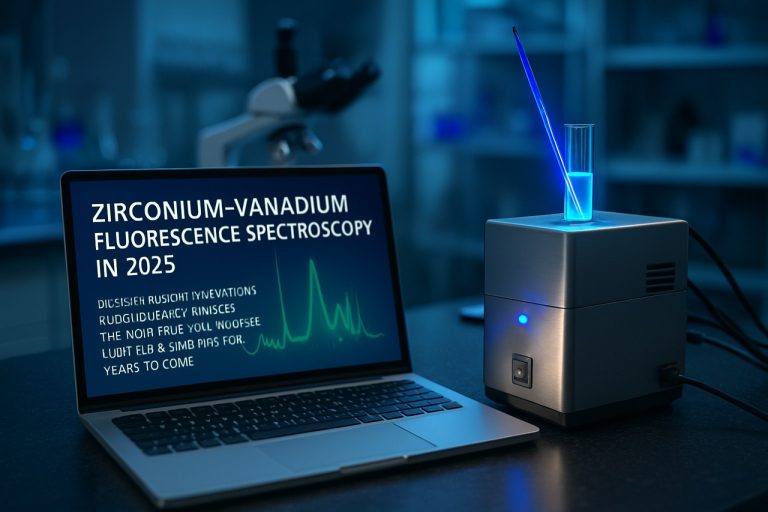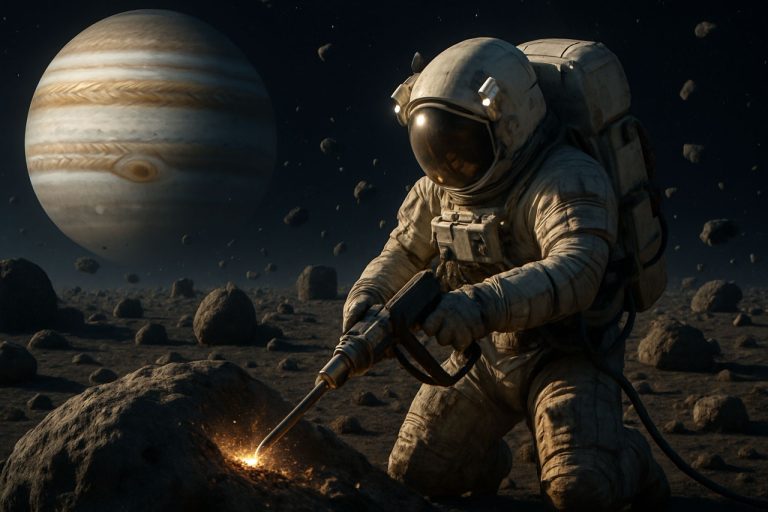
Jupiter Trojans Mining Tech 2025–2030: The $Trillion Race for Space Resources Revealed
Table of Contents
- Executive Summary: The State of Jupiter Trojans Mining in 2025
- Market Forecast: Investment, Revenue, and Growth Projections Through 2030
- Key Players and Strategic Partnerships: Leading Industry Consortia and Agencies
- Core Mining Technologies: Robotics, Extraction, and Refinement Systems
- Propulsion and Transportation: Advances in Deep-Space Mobility
- Legal and Regulatory Landscape: Space Treaties, Ownership, and Compliance
- Resource Potential: Composition, Value, and Demand for Trojans Materials
- Operational Challenges: Communication, Automation, and Risk Management
- Sustainability and Environmental Considerations for Space Mining
- Future Outlook: Roadmap to Commercialization and Next-Gen Innovations
- Sources & References
Executive Summary: The State of Jupiter Trojans Mining in 2025
In 2025, Jupiter Trojans asteroid mining remains largely in the conceptual and early technology demonstration phase. The Jupiter Trojans—two vast swarms of asteroids co-orbiting with Jupiter around its L4 and L5 Lagrange points—represent one of the most ambitious and technically challenging frontiers for resource extraction in the solar system. No mining missions have yet been launched to these distant bodies, but significant groundwork is being laid by space agencies and private industry to enable future operations.
The most notable recent development is NASA’s NASA Lucy mission, which launched in October 2021 and is currently en route to perform the first flybys of multiple Jupiter Trojans over the coming years. While Lucy is a scientific rather than mining mission, its advanced propulsion, navigation, and remote sensing instrument suite provide critical data on the composition, structure, and surface properties of Trojans—key parameters for mining planning. Early results from Lucy’s flybys, beginning in 2027, are expected to directly inform the technical requirements for extraction and processing technologies suitable for these bodies.
On the private sector front, companies such as TransAstra Corporation are developing solar thermal propulsion, asteroid capture, and in-situ resource utilization (ISRU) technologies under NASA contracts. While current demonstrations focus on near-Earth asteroids, the modularity and scalability of these systems are designed for eventual deployment to more remote targets, including Jupiter Trojans. For instance, TransAstra’s “Mini Bee” and “Worker Bee” spacecraft concepts, which use concentrated sunlight for asteroid excavation and processing, are being advanced for future deep-space mining applications.
Other technology pathways under active development include autonomous robotics for low-gravity surface operations, advanced optical navigation, and resource characterization instruments. Organizations such as The Planetary Society and NASA Jet Propulsion Laboratory are supporting research in autonomous optical navigation and sample acquisition, which are directly relevant for eventual Jupiter Trojan missions.
Looking ahead, the outlook for Jupiter Trojan mining technologies hinges on several key drivers: the successful navigation and data return of the Lucy mission, continued maturation of ISRU and robotic mining systems by industry, and international cooperation on deep-space infrastructure. While active mining operations are unlikely before the early 2030s, the ongoing work in 2025 is laying the technical, regulatory, and economic foundations for the next phase—when the Jupiter Trojans may become accessible for resource extraction and utilization.
Market Forecast: Investment, Revenue, and Growth Projections Through 2030
The Jupiter Trojans—asteroid swarms co-orbiting the Sun with Jupiter at its L4 and L5 Lagrange points—represent one of the most ambitious frontiers for asteroid mining, but the market outlook through 2030 remains largely speculative due to the significant technical and financial challenges of accessing these distant bodies. However, a combination of maturing deep-space propulsion, robotics, and in-situ resource utilization (ISRU) technologies is gradually shifting the paradigm, with investment landscapes beginning to respond.
As of 2025, market forecasts suggest that the Jupiter Trojans are not an immediate target for commercial extraction, with most private and governmental investment still focused on near-Earth asteroids (NEAs) and the lunar surface. However, several developments hint at a longer-term trajectory towards the outer Solar System. NASA’s NASA Lucy Mission, launched in 2021 and expected to arrive at its first Trojan target in 2027, is providing vital reconnaissance data on asteroid composition, resource potential, and operational hazards. This scientific foundation is crucial for future commercial ventures, and the mission has already spurred interest from space mining startups and established aerospace firms seeking to position themselves for the long-term prize of outer Solar System resources.
Investment in relevant enabling technologies is accelerating. Companies such as Maxar Technologies and Northrop Grumman are actively developing deep-space robotics and spacecraft propulsion solutions that could be adapted for Trojan operations in the late 2020s and early 2030s. Progress in high-efficiency solar electric propulsion, fueled by contracts from NASA and European Space Agency (ESA), is directly applicable to the long-duration missions required for Jupiter Trojan access. Meanwhile, startups like TransAstra Corporation are pursuing advanced optical mining and ISRU technologies, which are critical for extracting and processing volatiles and metals in situ, reducing the need for costly return missions.
Despite this activity, near-term revenue from Jupiter Trojan mining is not expected before 2030. Most forecasts predict that the period through the late 2020s will be dominated by technology demonstrations, precursor missions, and strategic investment rounds rather than commercial extraction or significant revenue streams. By the early 2030s, should the Lucy mission and follow-on robotic scouts confirm accessible resource deposits and validate operational protocols, the first commercial contracts and joint ventures for pilot mining missions may emerge. Industry groups such as Space Foundation and Space Mining and Resources Coalition anticipate a gradual expansion of the market, with cumulative investment in enabling technologies and precursor missions potentially reaching several hundred million dollars by 2030, laying the groundwork for exponential growth in the subsequent decade.
Key Players and Strategic Partnerships: Leading Industry Consortia and Agencies
The pursuit of mining operations within the Jupiter Trojans—vast swarms of asteroids sharing Jupiter’s orbit—remains a frontier ambition, but 2025 marks a period of intensified groundwork by international agencies and cross-sector consortia. While actual mining missions are likely a decade or more away, the foundations laid today will be pivotal for future endeavors.
Foremost among the key players is NASA, whose Lucy mission—launched in 2021 and en route to multiple Jupiter Trojan asteroids—serves as a technology demonstrator and data harvester for future mining activities. Lucy’s findings on asteroid composition, surface conditions, and regolith properties are expected to directly inform mining technology design and operational planning into the late 2020s. NASA’s continued collaboration with industry through programs such as the Space Technology Mission Directorate further cements its central role in developing mining-enabling technologies, from advanced propulsion to in-situ resource utilization (ISRU) systems.
On the commercial side, Planetary Resources and Deep Space Industries (DSI) previously led asteroid mining initiatives, though both have since shifted or merged, their legacy expertise now integrated into evolving aerospace partnerships and spinoffs. Several former DSI engineers are now part of Momentus, which focuses on in-space transportation—a critical capability for reaching and operating around Jupiter Trojans.
The European Space Agency (ESA) is also actively fostering international cooperation. Its Technology Development Element and exploration programs are increasingly aligned with asteroid resource utilization, and it works with companies such as Airbus on concepts for autonomous robotic mining and sample return technology. ESA’s partnerships with member states’ space agencies, including the German Aerospace Center (DLR), are advancing robotics and deep-space navigation systems crucial for Trojan operations.
Strategic alliances are also forming through larger public-private consortia. The Lunar and Planetary Institute and international bodies such as the United Nations Office for Outer Space Affairs (UNOOSA) are convening workshops and working groups to address legal, regulatory, and technical aspects of deep-space resource extraction, with direct implications for Jupiter Trojans.
In the next few years, expect closer integration between agencies and commercial entities. Joint technology demonstrators, shared infrastructure (such as deep-space communications and navigation networks), and collaborative mission architectures will be essential. The groundwork now underway—through data collection, technology maturation, and regulatory consensus—sets the stage for a new era in asteroid mining, with the Jupiter Trojans firmly in strategic focus.
Core Mining Technologies: Robotics, Extraction, and Refinement Systems
As the space sector pivots toward resource utilization beyond Earth orbit, the Jupiter Trojans—asteroid clusters sharing Jupiter’s orbit around the Sun—have emerged as highly tantalizing targets for long-term mining operations. Although no direct mining missions are currently scheduled for the Jupiter Trojans by 2025, technology development in core mining systems is rapidly advancing, laying crucial groundwork for future exploitation of these distant bodies.
Robotics and automation remain at the forefront of mining system design. Companies such as Maxar Technologies and Astrobotic Technology are actively developing robotic platforms for lunar and asteroid surface operations, which are expected to be directly scalable to the more challenging environment of the Jupiter Trojans. Their modular robotic arms, precision drilling units, and autonomous navigation algorithms—tested in lunar and near-Earth asteroid analogs—are being refined to withstand high radiation, low gravity, and extreme temperature fluctuations expected at Jupiter’s distance from the Sun.
On the extraction front, thermal mining and mechanical excavation systems are maturing as leading approaches. TransAstra Corporation is prototyping optical mining technologies that use concentrated sunlight to fracture and extract volatiles and minerals from asteroid regolith. While current demonstrations are Earth- and lunar-focused, the core principles—remote, energy-efficient resource liberation—are directly applicable to the Trojans, where sunlight is weaker but still available for concentrated thermal techniques.
Refinement and in-situ processing technologies are also seeing major progress. Momentus Inc. and ispace are advancing modular surface refineries that can process raw asteroid material into usable propellants or construction feedstocks. Although these systems are being prepared for cislunar and near-Earth missions in the late 2020s, their modularity and autonomous operation are critical stepping stones for eventual deployment to the more remote Jupiter Trojan region.
Looking ahead, the upcoming NASA Lucy mission, launched in 2021 and en route to study multiple Jupiter Trojans, is expected to deliver valuable compositional and environmental data by 2027, directly informing the engineering requirements for mining robots and extraction systems. As mission data becomes available, technology demonstrators and robotic prototypes are likely to be adapted for the unique challenges posed by the Trojans’ low gravity, deep-space location, and diverse mineralogy.
In summary, while Jupiter Trojans asteroid mining remains in a preparatory phase in 2025, core mining technologies—robotics, extraction, and refinement systems—are advancing rapidly, with current developments for lunar and near-Earth operations providing a strong foundation for the eventual exploitation of these distant asteroids over the next decade.
Propulsion and Transportation: Advances in Deep-Space Mobility
The propulsion and transportation systems required for missions targeting the Jupiter Trojans—the two vast swarms of asteroids leading and trailing Jupiter in its orbit—represent a formidable technological frontier in deep-space mobility. As of 2025, the focus is on maturing and demonstrating propulsion technologies capable of the multi-year journeys and high delta-V requirements necessary for round-trip mining operations to these distant bodies, which are located approximately 5.2 AU from the Sun.
NASA’s NASA Lucy mission, launched in 2021, is a pathfinder for such undertakings. Lucy employs large solar arrays and a sophisticated L’TES propulsion system (mainly bipropellant), and is demonstrating the feasibility of solar-powered operations at Jupiter’s distance. The mission’s trajectory—visiting multiple Trojans between 2027 and 2033—provides critical data on navigation, power management, and spacecraft resilience in the cold, low-light environment where mining operations would occur.
Electric propulsion is widely regarded as the most viable option for future asteroid mining missions targeting the Trojans. Companies such as Northrop Grumman and ArianeGroup are advancing high-power gridded ion and Hall-effect thrusters. These systems offer the high specific impulse needed for efficient, long-duration cruise phases, and recent test campaigns have validated performance at power levels well above those previously flown on interplanetary missions. For example, ArianeGroup and ESA’s successful 20 kW-class thruster tests mark a step toward scalable electric propulsion for large mining vehicles.
The logistics of mining at the Jupiter Trojans require robust in-space transportation architecture. Blue Origin has introduced the Blue Ring platform—a versatile orbital transfer and servicing vehicle intended for deep-space cargo delivery and support. While not yet deployed to the outer solar system, Blue Ring’s modular design and compatibility with multiple propulsion modes are shaping commercial approaches to large-scale resource extraction and sample return.
Looking ahead to the late 2020s, propulsion developments will focus on increasing system longevity, autonomy, and power efficiency. Continued data from Lucy’s operations, along with hardware demonstrations from industry leaders, will inform the design of next-generation mining spacecraft. These advances are expected to lower mission risk and cost, making the vast resources of the Jupiter Trojans incrementally more accessible for future mining ventures.
Legal and Regulatory Landscape: Space Treaties, Ownership, and Compliance
The legal and regulatory landscape for mining Jupiter Trojans—asteroids sharing Jupiter’s orbit around the Sun—remains a complex and evolving domain as of 2025. International agreements, national legislation, and emerging industry standards all shape the prospects for resource extraction from these distant celestial bodies.
The foundational framework for space activities is the United Nations Office for Outer Space Affairs (UNOOSA) Outer Space Treaty (OST) of 1967. The OST asserts that outer space, including the Moon and other celestial bodies, is not subject to national appropriation by any means. It also mandates that activities must be carried out for the benefit of all countries and that states bear international responsibility for national space activities, including those conducted by private entities.
However, the OST does not explicitly address the ownership of extracted resources. In response, some countries have enacted national legislation to clarify the rights of their citizens and corporations. The United States, through the U.S. Commercial Space Launch Competitiveness Act, grants American entities the right to own resources they extract from asteroids, subject to continued compliance with international agreements. Luxembourg has established a similar legal framework through its Law on the Exploration and Use of Space Resources, and the United Arab Emirates enacted its own regulations in 2019, with further updates expected as private and governmental interest grows.
As of 2025, no specific international regime governs resource extraction from Jupiter Trojans. The Moon Agreement (1979) does propose a shared heritage approach to celestial resources, but it has not been widely ratified by major spacefaring nations. This leaves a legal ambiguity that could affect long-term investment and operational planning.
On the compliance side, projects targeting Jupiter Trojans will need to adhere to space debris mitigation guidelines, planetary protection protocols, and licensing requirements set by their national authorities. For example, the U.S. Federal Aviation Administration’s Office of Commercial Space Transportation oversees commercial launches and operations for U.S. entities, ensuring adherence to domestic and international obligations.
Looking ahead, as interest in asteroid mining matures and missions to Jupiter Trojans become technically feasible—spurred by advances in propulsion, robotics, and in-situ resource utilization—there is growing pressure for the international community to clarify rules around resource rights, environmental stewardship, and dispute resolution. Initiatives such as the NASA Artemis Accords are fostering dialogue on best practices for responsible exploration, which may eventually influence governance models for Jupiter Trojan mining as well.
Resource Potential: Composition, Value, and Demand for Trojans Materials
The Jupiter Trojans—two vast swarms of asteroids co-orbiting with Jupiter at its L4 and L5 Lagrange points—represent one of the solar system’s most tantalizing resource reservoirs. Estimates suggest these bodies contain a mixture of silicates, organics, and volatiles, with sizes ranging from small boulders to objects hundreds of kilometers across. Understanding their composition is critical for evaluating their economic and strategic value, especially as the space sector eyes in-situ resource utilization (ISRU) to support deep-space missions and potential commercial ventures.
Spectral analysis from ground-based observations and space telescopes indicates that Jupiter Trojans are predominantly D- and P-type asteroids, rich in carbonaceous material, complex organics, and potentially water ice. The presence of water and volatiles is of particular interest for future deep-space infrastructure, as these resources can be converted into life support consumables and propellants, reducing the need for costly Earth launches. The value of such materials is amplified by the increasing ambitions for crewed exploration and commercial activity beyond Mars, where supply lines from Earth become impractical.
The next few years are set to be pivotal for advancing knowledge of the Trojans’ composition and mining potential. NASA’s Lucy mission, launched in 2021, is scheduled to reach its first Trojan target in 2027. While not a mining mission, Lucy will provide unprecedented close-range data on surface composition, regolith properties, and the presence of volatiles, directly informing future resource extraction technologies (NASA).
Several private sector players are investing in technology roadmaps that could enable mining of distant asteroids like the Trojans in the coming decade. Companies such as Planetary Resources and Deep Space Industries (now part of Bradford Space) have developed concepts for autonomous prospecting spacecraft, ISRU processing modules, and robotic mining systems. While current prototypes focus primarily on near-Earth asteroids, the core technologies—such as advanced optical navigation, miniaturized drilling, and in-situ volatile extraction—are applicable to the unique challenges posed by the Jupiter Trojans, including their distance from the sun and low-gravity environment.
Demand for asteroid-derived materials is expected to grow as lunar and Martian ambitions accelerate. Water, in particular, remains a strategic priority for both governmental and commercial actors planning long-duration missions. The potential value of the Trojans’ resources lies not just in their composition, but in their strategic position as stepping stones for outer solar system exploration. Over the next few years, data returned by Lucy and ongoing technical progress by industry will clarify the economic case for targeting Jupiter Trojans, setting the stage for future prospecting and, eventually, resource extraction missions.
Operational Challenges: Communication, Automation, and Risk Management
Mining the Jupiter Trojans—asteroid swarms orbiting at Jupiter’s L4 and L5 Lagrange points—presents an array of operational challenges, particularly in the interconnected domains of communication, automation, and risk management. As of 2025, these challenges are being scrutinized by both governmental agencies and emerging space mining ventures, with technological development and demonstration activities underway.
Communication Over Interplanetary Distances
The Jupiter Trojans are located approximately 5.2 astronomical units from the Sun, translating to a one-way signal delay of 35-50 minutes between Earth and the asteroids. This latency severely limits real-time remote operations and requires robust autonomous systems for mission-critical functions. NASA’s ongoing NASA Lucy mission, launched in 2021 and en route to fly by several Jupiter Trojans through 2033, is serving as a testbed for deep-space communication protocols and hardware endurance. Technologies such as high-gain Ka-band antennas and advanced error correction are being validated, with lessons applicable to future mining missions. Jet Propulsion Laboratory (JPL) continues to develop and test autonomous communications scheduling and delay-tolerant networking (DTN), preparing for the high-latency environment.
Automation and Autonomous Operations
Given the vast distances and communication delays, mining operations at the Jupiter Trojans will require unprecedented levels of automation. Key technology demonstrators include the NASA Asteroid Redirect Mission legacy developments and ongoing robotics research by ispace, inc., which is pioneering autonomous surface robotics and resource extraction systems designed for lunar and asteroid environments. These systems are being adapted for greater autonomy, leveraging machine learning for navigation, resource identification, and in-situ processing decisions. Meanwhile, Maxar Technologies is advancing modular spacecraft platforms capable of remote and autonomous operations, with potential adaptation for deep-space mining.
Risk Management in Harsh and Remote Environments
The operational risks at the Jupiter Trojans are amplified by their remoteness, extreme thermal cycles, high radiation, and uncertain surface properties. Agencies like European Space Agency (ESA) are incorporating advanced simulation and digital twin technologies to model mining scenarios and develop contingency protocols for equipment failure and resource unpredictability. In parallel, Northrop Grumman and others are investing in radiation-hardened avionics, redundant control systems, and autonomous fault detection and recovery mechanisms. ISRU (in-situ resource utilization) concepts tested by NASA and partners, such as autonomous excavation and refinery prototypes, feed directly into risk reduction for future Jupiter Trojan operations.
Outlook for the Next Few Years
From 2025 onward, the space industry will see continued maturation of key technologies through lunar and near-Earth asteroid missions led by NASA, ispace, inc., and new entrants. These missions serve as precursors, incrementally closing the technology gaps for eventual Jupiter Trojans mining. Advances in autonomous robotics, interplanetary communication, and resilient system design will be critical, with public and private sector collaboration accelerating progress toward operational readiness for the outer solar system.
Sustainability and Environmental Considerations for Space Mining
The sustainability and environmental considerations for mining Jupiter Trojans asteroids are increasingly integral to the development and deployment of mining technologies, particularly as the field moves from theoretical concepts toward early-stage mission planning in the mid-2020s. The vast distance to the Jupiter Trojans—asteroid swarms sharing Jupiter’s orbit, roughly 5 AU from the Sun—poses unique sustainability challenges distinct from near-Earth asteroid operations. Key concerns include spacecraft propulsion, energy use, extraction methods, and the long-term stewardship of the solar system environment.
In 2025, active mining of Jupiter Trojans remains in the preparatory phase, with significant sustainability work being conducted by organizations such as NASA and European Space Agency (ESA). NASA’s Lucy mission, launched in 2021, is now en route to perform flybys of several Trojans beginning in 2027, gathering critical data on their composition, structure, and regolith properties. This reconnaissance is essential for designing extraction systems that minimize disturbance to the asteroids and prevent the creation of hazardous debris in deep space.
Sustainable mining technologies being researched focus on electric propulsion systems, such as solar electric propulsion (SEP) and nuclear electric propulsion (NEP), which offer high efficiency for the long-duration missions required to reach and return from the Trojans. Companies like Axiom Space and Blue Origin are developing advanced in-space propulsion and infrastructure that could, in the coming years, support missions to these distant targets, with an emphasis on reusable spacecraft and in-situ resource utilization (ISRU) to reduce dependency on Earth-supplied fuel.
Environmental stewardship in asteroid mining is being addressed through the development of best practices and guidelines by industry groups such as the Secure World Foundation and the Inter-Agency Space Debris Coordination Committee (IADC). These organizations are working to ensure that mining technologies avoid the uncontrolled release of debris, do not destabilize Trojan orbits, and preserve the scientific value of these primordial bodies.
Looking ahead, the outlook for sustainable Jupiter Trojans mining technologies in the next few years centers on continued data-gathering, technology demonstrations for low-impact extraction, and the refinement of international environmental protocols. As the sector moves closer to prospecting and, eventually, resource extraction, collaboration among space agencies, technology developers, and regulatory bodies will be crucial to ensuring that mining operations preserve both the asteroids themselves and the broader solar system environment for future generations.
Future Outlook: Roadmap to Commercialization and Next-Gen Innovations
The prospect of mining the Jupiter Trojans—asteroid swarms sharing Jupiter’s orbit—signals a transformative leap in space resource utilization. As of 2025, the roadmap toward commercial exploitation of these distant bodies is defined by ambitious international missions, evolving propulsion and robotics technologies, and the gradual maturation of in situ resource utilization (ISRU) capabilities.
The NASA NASA Lucy mission, launched in 2021, is set to conduct its first flybys of Trojan asteroids between 2027 and 2033. Lucy’s close observations will deliver crucial data on the composition, structure, and dynamics of these ancient objects, informing both engineering requirements and economic assessments for future mining missions. The data stream from Lucy is expected to sharpen industry roadmaps for prospecting, landing, and extraction systems tailored to the unique characteristics of Trojan asteroids.
Current propulsion capabilities are a major limiting factor for commercial asteroid mining in the Jupiter region. However, next-generation high-efficiency electric propulsion systems are under active development. Companies such as ArianeGroup and Northrop Grumman are advancing ion and Hall-effect thrusters, which could enable the multi-year transit and complex orbital maneuvers necessary for Trojan operations.
Robotic autonomy is another critical focus, with companies like Astrobotic Technology and Maxar Technologies progressing toward highly autonomous landers and manipulators capable of operating with minimal latency and human intervention. Developments in robust, radiation-hardened electronics and machine learning-based navigation systems are poised to make remote mining feasible in the harsh environment near Jupiter.
Resource extraction and processing technologies, such as microwave sintering for regolith extraction and water ice electrolysis for propellant production, are being prototyped for use in low-gravity environments. NASA’s ISRU program continues to develop and test mining hardware and processing modules that can be adapted for long-duration missions far from Earth.
In the next few years, the convergence of deep-space robotic demonstrations, improved propulsion, and ISRU field tests—coupled with regulatory frameworks being shaped by organizations like the United Nations Office for Outer Space Affairs—will define the commercial timeline. The sector anticipates that by the early 2030s, sustained prospecting and pilot-scale resource extraction in the Jupiter Trojan region may become technically and economically viable, laying the groundwork for next-generation industrial activity in the outer solar system.
Sources & References
- NASA
- TransAstra Corporation
- The Planetary Society
- Maxar Technologies
- Northrop Grumman
- European Space Agency (ESA)
- TransAstra Corporation
- Lucy mission
- Deep Space Industries
- Momentus
- Airbus
- DLR
- United Nations Office for Outer Space Affairs
- Astrobotic Technology
- ispace
- Blue Origin
- Law on the Exploration and Use of Space Resources
- Axiom Space
- Astrobotic Technology
- Maxar Technologies



